Picture this: you’re walking down the street, enjoying a peaceful afternoon stroll, when suddenly you see a Finnish Spitz by your side. With its striking orange-red coat and curly tail, the Finnish Spitz is a breed known for its friendly and sociable nature. But when does this lovable companion transform into a protective guardian? In this article, we will explore the fascinating world of the Finnish Spitz and uncover the key factors that trigger their protective instincts. So, if you’re curious about when and why Finnish Spitz become protective, look no further – we have all the answers right here.
Finnish Spitz Characteristics
Size
The Finnish Spitz is a medium-sized dog breed. Adult males typically stand between 17.5 and 20 inches tall at the shoulder, while females are slightly smaller, ranging from 15.5 to 17.5 inches in height. In terms of weight, males usually weigh between 31 to 40 pounds, while females weigh between 23 to 35 pounds.
Appearance
The Finnish Spitz has a distinct and elegant appearance. They have a well-proportioned body with a deep chest and a muscular build. Their head is fox-like, with a pointed muzzle and erect ears. Their eyes are almond-shaped and express a friendly and intelligent expression. The breed’s most striking feature is their beautiful coat, which consists of a dense and fluffy double coat. Their outer coat is vibrant red or golden, while the undercoat is soft and insulating.
Temperament
Finnish Spitz dogs have a playful and friendly temperament. They are known for their sociability and love for human companionship. These dogs are typically good with children and can be excellent family pets. They are loyal and devoted to their owners, often forming strong bonds with their family members. Finnish Spitz dogs are also alert and make excellent watchdogs due to their protective nature. While they may be reserved with strangers, they are generally not aggressive.
Trainability
The Finnish Spitz is an intelligent breed that is generally eager to please their owners. They are quick learners and respond well to positive reinforcement training methods. Using rewards such as treats, praise, and play can motivate them to learn new commands and tricks. However, it is important to note that they can be independent thinkers at times, so consistent and patient training is necessary to achieve desired results. Early socialization and obedience training are essential to raise a well-rounded Finnish Spitz.
Understanding Protective Behavior in Dogs
What is Protective Behavior?
Protective behavior in dogs refers to their natural instinct to guard and protect their family and territory. It is a normal behavior that can manifest in various ways, such as barking, growling, and posturing. Protective behavior stems from a dog’s loyalty and desire to keep their loved ones safe from potential threats or dangers.
Reasons for Protective Behavior
There are several reasons why dogs exhibit protective behavior. One of the primary reasons is their instinct to safeguard their territory. Dogs view their homes and immediate surroundings as their territory, and they feel the need to protect it from intruders or perceived threats. Another reason for protective behavior is their strong bond with their family members, whom they consider part of their pack. Dogs feel responsible for the safety and well-being of their family and may become protective to ensure their welfare.
Signs of Protective Behavior
Dogs may display various signs of protective behavior when they perceive a threat or feel the need to protect their family or territory. These signs can include barking or growling at strangers, standing tall and appearing alert, and showing an assertive or defensive body posture. They may also exhibit behaviors such as lunging or guarding their family members, possessions, or territory. It’s essential to understand these signs to differentiate between protective behavior and aggression.

Socialization and Protective Behavior
The Importance of Early Socialization
Early socialization plays a crucial role in shaping a dog’s behavior, including their level of protectiveness. Introducing a Finnish Spitz puppy to various people, animals, environments, and situations from an early age helps them develop confidence, adaptability, and appropriate social skills. Proper socialization can reduce the likelihood of an overprotective or fearful dog and contribute to a well-adjusted and friendly adult dog.
Socializing Finnish Spitz
To socialize a Finnish Spitz, expose them to different experiences gradually. Invite friends and family members to interact with your puppy, ensuring positive and pleasant encounters. Arrange playdates with other friendly dogs to promote positive interactions and improve their social skills. Take your Finnish Spitz to various environments such as parks, markets, and busy streets to familiarize them with different sights, sounds, and smells. Positive experiences during socialization will help shape their protective behavior in a positive and balanced way.
Reducing Overprotectiveness through Socialization
While it is desirable for a Finnish Spitz to possess a certain level of protectiveness, it is important to prevent overprotective tendencies. Overprotectiveness can lead to excessive barking, aggression, and fear-based behaviors. To reduce overprotectiveness, continue socializing your Finnish Spitz throughout their life. Expose them to new experiences regularly, reinforce positive behavior, and provide them with appropriate outlets for their energy and instincts, such as interactive toys and games.
Training and Protective Behavior
Positive Reinforcement Training
Positive reinforcement training is highly effective when it comes to shaping a Finnish Spitz’s behavior, including their protective instincts. This training method involves rewarding desired behaviors with treats, praise, and play, while avoiding punishment or harsh corrections. By rewarding your dog for calm and appropriate responses to perceived threats, you can reinforce their protective behavior in a positive and controlled manner.
Building Trust and Confidence
Establishing trust and building your Finnish Spitz’s confidence is crucial in training them to handle protective situations appropriately. Provide them with a secure and structured environment and ensure they have positive experiences with strangers. Gradually expose your dog to different people, allowing them to approach and interact at their own pace. Reward your Finnish Spitz for remaining calm and relaxed, reinforcing their confidence in unfamiliar situations.
Teaching Appropriate Responses to Strangers
To ensure your Finnish Spitz reacts appropriately to strangers, teach them appropriate responses through training. Start with basic obedience commands such as sit, stay, and leave it. Once these commands are well-established, introduce controlled encounters with unfamiliar individuals. Encourage your Finnish Spitz to remain calm and controlled in the presence of strangers. Reward calm behavior and redirect any signs of aggression or fear with positive reinforcement techniques. Consistency and positive reinforcement will help shape their behavior effectively.

Finnish Spitz as Guard Dogs
Traits That Make Finnish Spitz Good Guard Dogs
Finnish Spitz dogs possess several traits that make them suitable as guard dogs. Their alert and attentive nature allows them to quickly detect potential threats and raise the alarm through barking. Their protective instincts, combined with their loyalty and devotion to their family, drive them to defend their loved ones and their territory. Additionally, their loud and distinctive bark can serve as a deterrent to potential intruders.
Guarding Instincts and Behaviors
The guarding instincts of Finnish Spitz dogs are deeply rooted in their heritage as hunting dogs and watchdogs in Finland. They have a strong territorial instinct and a natural propensity to alert their owners to any perceived threats. Finnish Spitz dogs may exhibit behaviors such as barking, growling, and keeping a close watch on their surroundings when in protective mode. However, it is important to provide them with appropriate training and guidance to prevent their protective behaviors from becoming excessive or aggressive.
Training Finnish Spitz as Guard Dogs
Training your Finnish Spitz as a guard dog should focus on encouraging their natural protective instincts while teaching them appropriate responses to different situations. Start with basic obedience training to establish a foundation of control and respect for your commands. Introduce specific guard dog training exercises, such as teaching them to bark on command and to cease barking on command. Consistent and positive reinforcement training techniques will allow you to channel their protective instincts effectively and maintain control over their behaviors.
Protective Behavior towards Family Members
Devotion to Family
Finnish Spitz dogs are known for their deep devotion and loyalty to their family members. They form strong bonds with their owners and consider them an integral part of their pack. Due to this strong bond, Finnish Spitz dogs exhibit protective behavior towards their family members, often considering their well-being as their primary responsibility.
Protectiveness towards Children
Finnish Spitz dogs generally exhibit a gentle and caring nature towards children. Their protective instincts may be particularly heightened when it comes to safeguarding younger family members. However, it is crucial to supervise interactions between dogs and children, especially to ensure that play remains safe and respectful. Teaching children the proper ways to approach and interact with the dog will help foster a positive and harmonious relationship between the Finnish Spitz and the children.
Addressing Overprotectiveness towards Family
While protective behavior towards family members is desirable up to a certain extent, overprotectiveness can lead to issues such as possessiveness, aggression, and anxiety. If you notice signs of overprotectiveness, it is essential to address them promptly. Enlist the help of a professional dog trainer or behaviorist to assess the situation and provide appropriate guidance. Training exercises and behavior modification techniques can help manage and redirect overprotective tendencies, creating a safer and more balanced environment for both your Finnish Spitz and your family.
Protective Behavior towards Strangers
Wariness towards Strangers
Finnish Spitz dogs can be reserved or wary around strangers, which is an inherent trait of their protective nature. This wariness is usually exhibited through cautious behavior, alertness, and vocalization. They may bark or growl when encountering unfamiliar individuals, signaling their protective instincts and potential discomfort with the situation. However, with proper socialization and training, Finnish Spitz dogs can learn to differentiate between genuine threats and harmless strangers.
Protecting Territory
Finnish Spitz dogs have a strong territorial instinct, which means they may exhibit protective behavior towards their home and immediate surroundings. When strangers approach their territory, Finnish Spitz dogs may become more vigilant, increase barking, or show assertive body language to deter potential intruders. While this protective behavior can be beneficial, it is important to manage it through training to prevent it from escalating into aggression or excessive territoriality.
Preventing Aggressive Reactions towards Strangers
To prevent Finnish Spitz dogs from reacting aggressively towards strangers, it is crucial to provide them with appropriate socialization and training. Early exposure to various social situations, people, and dogs can help them become more comfortable with unfamiliar individuals. Use positive reinforcement techniques to reward calm and appropriate behavior when encountering strangers. Engage in controlled encounters, gradually increasing exposure to new people, while ensuring the dog remains relaxed and receptive. Through consistent training and positive experiences, you can help your Finnish Spitz develop a balanced and discerning approach towards strangers.
Protectiveness in Specific Situations
Protectiveness during Walks or Outings
During walks or outings, Finnish Spitz dogs may display increased alertness and protectiveness, especially if they perceive potential threats or feel their owners are in danger. It is important to maintain control over your dog’s behavior by reinforcing leash manners and obedience training. Teach your Finnish Spitz to walk calmly on a leash, and use positive reinforcement to reward good behavior. With consistent training and exposure to various environments, you can help your dog learn to differentiate between genuine threats and harmless situations.
Protectiveness at Home
The Finnish Spitz’s protective instincts are often most evident in their behavior at home. They may bark or growl when they hear unfamiliar noises or sense someone approaching their property. While it is normal for dogs to exhibit this behavior, it is crucial to manage it and prevent excessive barking or aggression. Training your Finnish Spitz to respond to your cues and rewarding them for appropriate behavior can help control their protective instincts effectively. Providing mental and physical stimulation through interactive toys and regular exercise can also help alleviate their need to be constantly on guard.
Protectiveness in Unfamiliar Environments
When taken to unfamiliar environments, Finnish Spitz dogs may initially exhibit cautious behavior and protectiveness due to their instinctual nature. It is essential to provide them with gradual exposure to new environments and experiences to help them feel more comfortable and secure. Use positive reinforcement training techniques to reward calm behavior and gradually increase the level of stimulation and new experiences. Over time, your Finnish Spitz will become more confident and adaptable in unfamiliar settings.
Warning Signs of Aggression
Growling and Barking
Growling and excessive barking can be warning signs of potential aggression in Finnish Spitz dogs. While barking and growling can be part of their protective behavior, continuous or escalating vocalization can indicate a more aggressive response. It is important to assess the situation and consider the context in which the behavior is occurring. If your Finnish Spitz shows signs of aggression during protective instances, consult a professional trainer or behaviorist for guidance.
Snapping or Biting
Snapping or biting is a serious sign of aggression and should never be taken lightly. If a Finnish Spitz resorts to snapping or biting when in protective situations, it is crucial to address the behavior promptly and seek professional help. Aggressive behaviors can result from fear, anxiety, or a lack of appropriate socialization. A professional trainer or behaviorist can assess the situation, create a behavior modification plan, and guide you in managing and correcting these aggressive tendencies.
Stiff Body Language
A stiff or rigid body posture can indicate heightened arousal and potential aggression in Finnish Spitz dogs. When they feel the need to protect their family or territory, their body language might become more tense or rigid. Watch for signs such as raised hackles, a rigid tail, and a fixed or intense gaze. If your dog consistently displays stiff body language during protective instances, consult a professional for evaluation and guidance on managing their behavior.
Seeking Professional Help
Consulting a Professional Trainer or Behaviorist
If you are facing challenges with your Finnish Spitz’s protective behavior, it is advisable to seek the help of a professional dog trainer or behaviorist. A qualified professional can assess the situation, identify the underlying causes of the behavior, and develop a personalized training plan to address your dog’s specific needs. They can guide you in implementing effective training techniques and provide ongoing support to ensure the safety and well-being of both your Finnish Spitz and your family.
Behavior Modification Techniques
Behavior modification techniques are often employed to address protective behavior in dogs. These techniques aim to modify your dog’s response to perceived threats by gradually desensitizing them and teaching more appropriate and calm behaviors. Through systematic desensitization and counterconditioning, your Finnish Spitz can learn to associate protective situations with positive experiences, gradually reducing their reactivity and fear-based responses.
When to Seek a Veterinarian’s Advice
In some cases, protective behavior in dogs may be rooted in underlying medical issues or physical discomfort. If you suspect that your Finnish Spitz’s behavior is influenced by pain or illness, it is advisable to consult a veterinarian. They can conduct a thorough examination, rule out any medical causes for the behavior, and provide appropriate treatment or recommendations. A veterinarian’s input can complement the training and behavior modification efforts, ensuring a holistic approach to managing your dog’s protective behavior.
In conclusion, Finnish Spitz dogs possess natural protective instincts and can exhibit a variety of behaviors to guard their loved ones and their territory. Through proper socialization, training, and guidance, their protective nature can be channeled in a positive and controlled manner. It is crucial to address any overprotectiveness or aggressive tendencies promptly and seek professional help when needed. With patience, consistency, and positive reinforcement, you can create a balanced and well-behaved Finnish Spitz that is a loyal companion and a reliable protector.
